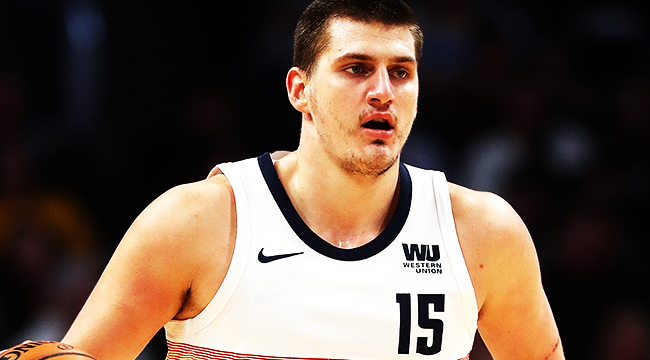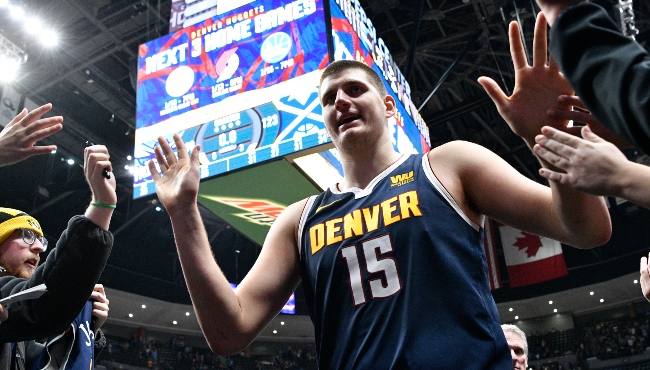
There’s something inspiring about watching Nikola Jokic play basketball. He does not look like someone who should be an elite professional athlete — outside of being a seven-footer, Jokic is a doughy, tired-looking guy who, when a basketball game starts, is capable of ripping your heart out and stomping on it with the weirdest game possessed by any superstar in the league.
Yes, Jokic is a superstar. But that distinction also might not go far enough in emphasizing just how good he is. Jokic is the best player on a team that, up until they got obliterated by the Golden State Warriors earlier this month, sat atop the Western Conference despite Gary Harris, Paul Millsap, and Will Barton all missing extended time due to injuries. If he was doing this sort of thing on a team with a bigger national profile than the Nuggets — which have played in four nationally televised games this season (their fifth is on Wednesday night, at least!) — Jokic’s name would pop up more prominently in All-Star and, yes, MVP discussion than we’ve seen.
Which begs the question: How on earth did the guy who (justifiably!) inspired this tweet turn into a potential All-NBA center for a team with legitimate championship aspirations?
Really like Jokic's game. YMCA type game. Can't jump over a phone book but can shoot it, can pass, great feel. Ball fakes, up & unders, etc
— Mike Schmitz (@Mike_Schmitz) June 27, 2014
Well, the answer is basically that Jokic is awfully good at essentially every basketball skill, even if not possessing all of the athletic abilities that we typically ascribe to elite basketball players. He is as skilled of a big man as the NBA has ever seen, which certainly seems like a hyperbolic statement, but you should not be able to do this sort of thing as a slow-footed seven footer.
Too easy for Jokic 🃏 pic.twitter.com/yTIADnOUNx
— NBA on ESPN (@ESPNNBA) January 18, 2019
This is insanity! Being able to put the ball on the floor is an increasingly useful skill for big men to have, but Jokic possesses the ability to do stuff like this with ease. It’s not like this is a new skill or anything like that — Jokic’s ability to handle the rock and get just enough space to do something is a hallmark of his game — but it’s one of those skills that makes it easy for Denver to put the ball in Jokic’s hands, let him go do something, and have it work.
For the 2018-19 season, Jokic is used on 30.1 percent of the Nuggets’ possessions, putting him in the 97th percentile among all centers, per Cleaning the Glass. It’s easy to assume that Jokic has the ball in his hands a ton based on the fact that he leads the Nuggets in scoring and assists per game. The former is what you’d expect out of a star player, but his assist percentage is 39 percent, the fourth-highest mark in the league. The only players ahead of him are Russell Westbrook, James Harden, and John Wall.
The word “breathtaking” can best describe some of the passes we see out of Jokic. His feel for the game and inherent understanding of where his teammates are — and in some cases, are going to be — is legitimately special. Take, for instance, this pass to Jamal Murray during Denver’s game against the Clippers earlier this month. Jokic has the ability to initiate a fast break after a rebound thanks to his ability to handle the rock, but there’s nothing like when he fires an outlet pass that leads to a bucket.
JOKIC WITH A DIME. 😱🔥 pic.twitter.com/WXcPqJGrmH
— House of Highlights (@HoHighlights) January 11, 2019
This one was especially crazy, because he brings the ball in with one hand, looked down the court, saw Murray, and dropped a picture-perfect pass into his breadbasket en route to two points in, per the stopwatch on my cell phone, 2.15 seconds.
Murray has built up quite the rapport with Jokic, as the crafty guard receives a hair under 31 passes from his big man every game, and 43.7 percent of the passes Jokic throws in a game heads to Murray. For reference, none of those aforementioned three dudes ahead of Jokic in assist rate throw as many passes to a single teammate than he does to Murray — the closest was Wall, who threw 20.3 passes per game to Bradley Beal before he was sidelined due to heel surgery. That’s been reciprocated, too, as 45 percent of the passes Jokic receives every game (26.5 a night) come from Murray. That two-man game is part of what’s helped keep the Nuggets not only afloat, but playing at a high level amid various injury issues.
On the whole, it is remarkable how much the Nuggets use Jokic as the guy who makes their offense go. Jokic leads the NBA in passes made per game, and he’s tied for 14th in the league in potential assists per game. He is the fulcrum at the center of what Denver looks to do offensively, someone whose ability to get the ball to his teammates in positions to score and in positions to make plays is special.
Jokic has managed to get buckets despite taking a step back from the field this year. His effective field goal percentage is 54.4 percent, slightly above where it was during his rookie campaign. Despite averaging 19.6 points per game, his three point shooting has dropped precipitously, from 39.6 percent in 2017-18 to 32.3 percent this year. He’s also cut back the percentage of midrange shots he takes — 44 percent of his attempts qualified as midrange last year, 36 percent this year — even though his field goal percentage this season is one percentage point lower than it was during the previous campaign.
He has, however, upped the number of shot attempts he takes at the rim. Despite shooting a tiny bit better at the rim this season, 41 percent of his shot attempts come at the basket, compared to 31 percent a year ago. Per NBA.com, Jokic is already 100 attempts at the rim shy of the number of attempts he got at the basket in all of 2017-18. A perpetual advanced stats darling, Jokic is in the top-10 in win shares, offensive win shares, player efficiency rating, box plus/minus, and value over replacement player.

The issues that you would expect defensively with Jokic do exist, although he is able to use his beefiness (listed weight: 250 pounds), wingspan (listed at 7’3), and understanding of where he needs to be on a basketball court to his advantage. He’s not a great shot blocker — he averages fewer than one a game — but he’s decent enough at altering shots when he’s in a position to do so that, at the very least, he can contribute that way.
The best asset he might possess on the defensive end may be that he knows how to stay out of foul trouble — he averaged 2.6 fouls per game as a rookie, 2.9 as a sophomore, and 2.8 in each of the last two years as his workload has gone up. Per basketball-reference, he’s one of eight centers this season to play at least 30 minutes per game and record fewer than three fouls a night, and of those eight, no one is worse at blocking shots than him. Jokic has also only fouled out of one game this season, and has picked up five fouls in four other games.
Denver is a little better defensively when he is off the floor — the team’s defensive rating is 106.2 in 1,396 minutes with Jokic playing and 103.3 in 774 minutes of Jokic resting. Still, Jokic has a defensive box plus/minus of +3.3, the best mark of his career and the best mark on the Nuggets outside of Mason Plumlee. He has also been worth 2.2 defensive win shares, which leads the team.
In an era of basketball where the most valuable big men are the ones who have unique skill sets, Jokic still finds a way to stick out, precisely because he is so skilled that it gives him a leg up on his competition. His best asset is his brain, something that he uses to his advantage whenever he steps on the floor. It’s helped make him into a superstar, and even though his name doesn’t pop up too terribly much when discussing the best players in the world — the honest-to-god, MVP-caliber guys — it’s time Jokic starts to get the praise he deserves.






